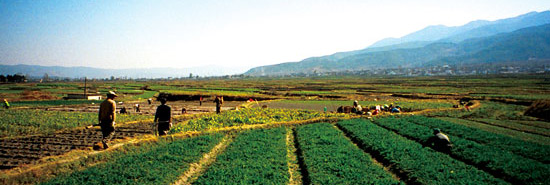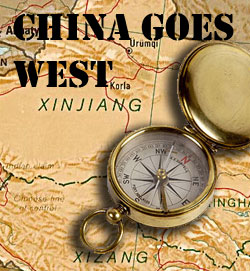Investing in Yunnan: ASEAN, Adventure Tourism, Myanmar and India’s Elephant in the Backyard

 Aug. 31 – Yunnan has always been an enigmatic province; encompassing four major Chinese minorities influenced by Vietnam, India, Burma and Tibet, and home to the very eastern end of the Himalayan ranges, it is never a simple region to categorize.
Aug. 31 – Yunnan has always been an enigmatic province; encompassing four major Chinese minorities influenced by Vietnam, India, Burma and Tibet, and home to the very eastern end of the Himalayan ranges, it is never a simple region to categorize.
However, due to booming trade with the Association of Southeast Asian Nations (ASEAN) free trade area, the central government has begun to pay more attention to China’s most southwest province. The priority has been upgrading Yunnan’s transport links internationally in order to connect it to countries across the ASEAN region and to its provincial neighbors within China.
Add to that ASEAN’s massive bilateral trade figure with China, some US$205 billion, and Yunnan, rather like Guangxi, starts to become attractive when considering multilateral trade with ASEAN members from cities such as Kunming. Indeed, Yunnan’s trade with its neighboring regions is growing:

Yunnan’s only drawback is that it is landlocked. The nearest Chinese ports are at Qinzhou, Guangxi to the east, but rail connections are improving directly to Hanoi, with freight crossing the borders at Pingxiang, and Hekou. Only Hekou is open to non-Chinese Vietnamese. It should also be noted that Yunnan’s largest trade partner is Hong Kong, followed by Myanmar, South Korea, the United States and Japan. Trade with Vietnam and India is expected to grow dramatically in the near future as transportation links open up.
Major highways in Yunnan connect to Guizhou, Guangxi, Sichuan and Tibet. In the past few years Yunnan has built more new roads than any other province in China. The target is to connect all major towns and neighboring capitals by 2010, and to complete a high-speed network by 2020. There are also highways going to Myanmar, Thailand (through neighboring Laos), and Vietnam. In addition, India and China will redevelop and reopen the Stilwell Road, which will connect Kunming with Ledo in Northeast India. The road will improve links between Yunnan and India dramatically and reduce the current trade route between India and China by 75 percent. At present, goods must first be transported to Guangxi or Guangdong and then travel to India by ship – a journey of 6,000 kilometers. When the road is upgraded and completed (expected 2016) then Kunming will start to boom even more.
The province is also in the middle of a RMB80 billion project to build 12 new railway lines. This includes a line from Dali to Shangri-la, Yuxi to Hekou, and Yuxi to Mohan. Local officials plan to have a total of 3,750 kilometers of railway in the province by 2020 with the aim of improving links within Yunnan to its neighboring provinces, as well as ASEAN countries to the south. China will also fund around 75 percent of a planned pan-Asian railway, which will link China (through Yunnan) to many of Asia’s largest cities including Bangkok, Kuala Lumpur and Singapore. The line is expected to be completed around 2015. Other lines will connect Yunnan with major cities in Myanmar, Laos, Vietnam and Cambodia.
There are nine civil airports in the province located in the cities of Kunming, Dali, Baoshan, Xishuangbanna, Simao, Zhaotong, Lijiang and Diqing. Kunming Wujiaba International Airport is among the oldest airports in China, with a history that dates back over 100 years. In 2007, work began on a new terminal here that is projected to be the third or fourth largest in China upon completion in 2011-2012. Once operational, the new airport is expected to greatly enhance Kunming’s international connectivity via new routes to Europe, North America, South Asia and Australia.
Despite Yunnan’s abundant rivers and water resources, only small sections are navigable. Around 1,300 kilometers of inland waterways are used for transport primarily on the Jingsha and Lancang (Mekong) Rivers, with ports at Dali, Shuifu, Jinghong, Suijiang and Simao. The Chinese government plans to invest RMB367.5 million to upgrade international shipping channels, particularly those of the Mekong River which will effectively double the tonnage of ships on the river from 100 to 200 tons.
On the back of China’s booming trade with neighboring ASEAN countries, as well as redeveloping ties with India, Yunnan is experiencing steady overall growth. The province has maintained 9 percent growth in the past few years, and has seen rapidly increasing foreign investment as infrastructure projects have allowed the province to become China’s gateway to Southeast Asia.
Yunnan has five pillar industries: bio-resources, power, tobacco, mining and tourism. Yunnan is the country’s largest tobacco producer. Tourists are attracted by the province’s ethnic diversity, natural scenery, attractive towns and cities, and comfortable climate. These industries helped Yunnan’s GDP reach RMB472.2 billion in 2007, an increase of 12.3 percent from the previous year. Though agriculture is a big contributing factor to Yunnan’s economy, only 6 percent of the total land is agriculturally fertile, producing rice, maize, wheat, sugar beets, yams, tobacco and coffee.
Contracted FDI has more than doubled in the past two years, reaching US$1.2 billion in 2009. Exports in 2009 were worth a total of US$5.6 billion, a 39.6 percent increase from the previous year.
China’s planning ministry has approved an oil pipeline from Sittwe, a deep-water port in Myanmar, to Kunming as an alternative route for China’s crude imports.
Yunnan also possesses a number of strategically important development zones.
Kunming Hi-Tech Development Zone
Located to the northwest of Kunming, this is the only state-level high-tech park in the province and has close links with Yunnan University, Kunming University of Science and Technology, and Yunnan Normal University. Investments in bio-pharmaceuticals, information technology, electronics, new materials, and optical-mechanical-electrical integration technologies are all encouraged in the park.
Kunming Economic and Technological Development Zone
The area is a state-level zone that was first established in 1992, and now has a developed area of six square kilometers from a planned total of 9.8 square kilometers. It is situated to the east of Kunming, at 1,893 meters above sea-level. It is four kilometers from downtown Kunming, where the highways take you straight to the China-Laos border town of Mohan, the China-Vietnam border town of Hekou, and the China-Myanmar border town of Ruili. All three border towns are rated Grade A border ports of China.
A railroad network has been built around Kunming, consisting of the Guiyang-Kunming, Chengdu-Kunming, Nanning-Kunming, Kunming-Dali and Yunan-Vietnam railways. The zone is two kilometers away from the Kunming East Railway Station and four kilometers from the Kunming South Railway Station. Both are rail centers for cargo and passenger transportation.
The Kunming International Airport is only 1.8 kilometers away from the zone. It operates eight air routes to overseas airports such as Singapore, Rangoon, Kuala Lumpur, Seoul, Osaka, and more than 70 domestic routes to Hong Kong, Macau and other cities.
The zone has access to ocean shipping at the Beihai and Fangcheng Ports in Guangxi province via the Nanning-Kunming railway, at Zhanjiang port of Guangdong province via the Guiyang-Kunming railway, at Shanghai Port, and at Haiphong, Vietnam via the Yunnan-Vietnam Railway.
Its pillar industries include the tobacco and related industries, IT and electronics manufacturing, bio-pharmaceuticals, food processing and the new materials development industry.
Authorities encourage investment in industries such as integrated optical-electric-mechanical, bio-food and bio-pharmaceuticals. Greater efforts will also be made for the development of information electronics, high-efficiency agriculture, new materials, new building materials and environment-friendly technologies.
Hekou Border Economic Cooperation Area
Likewise, the Hekou Border Economic Cooperation Area aims to promote border trade between China and Vietnam. Approved as a state-level border zone in the early 1990s, there is a bridge from the zone which runs into Vietnam and is connected to Ho Chi Minh City and Hanoi via the Yunnan-Vietnam Railway. Total trade levels from the region are on a steady increase on the back of increasing Sino-Vietnamese trade. Main exports include clothing, cotton yarn, ceresin wax, mechanical equipment, batteries, fruit, and tobacco.

Chris Devonshire-Ellis with China’s Minister for Tourism, Shao Qiwei, back in 2003
As can be gathered, Yunnan has an important tourism industry, with outdoor sports, hiking, mountaineering and extreme sports all taking off here. This is expected to develop – the current Minister of Tourism, Shao Qiwei, is originally from Kunming and served as vice-mayor and vice-governor before his appointment. Consequently, with Tibet to the north, some spectacular scenery, mountains and rivers running through, and a developing border area with Myanmar and Vietnam, travel and tourism related companies, including equipment manufacturers, are targeting production and services in Yunnan.
Yunnan’s destiny therefore runs along several lines, a developing adventure tourism industry, the production and sale of flowers and fruits (Kunming is now the world’s largest producer and exporter of flowers), in addition to developing ties and trade with ASEAN. For businesses looking to develop trade in Southeast Asia, a base from Kunming makes absolute sense. Plus, the “city of eternal spring” has one of China’s better living and working environments. The connections with India should also not be underestimated. Kunming is home to the annual Sino-India Trade Fair, at which each country displays goods, and develops trade and understandings. While Myanmar may lie between them, it is the potential for China-Indian trade that may yet become the major driver within Yunnan.
Parts of this article were excerpted from the China Briefing Business Guide to West China.
Chris Devonshire-Ellis is the principal and founding partner of Dezan Shira & Associates, establishing the firm’s China practice in 1992. The firm now has 10 offices in China. For advice over China strategy, trade, investment, legal and tax matters please contact the firm at info@dezshira.com. The firm’s brochure may be downloaded here. Chris also contributes to India Briefing , Vietnam Briefing , Asia Briefing and 2point6billion
Related Reading
The Complete “China Goes West” Series
(Covering all of China’s western regions and their investment potential)
China Developing Cross Border Trade Links With India
Kunming City Guide
(Complimentary PDF download)
Business Guide To West China
(Includes overviews of the Provinces of Gansu, Guizhou, Ningxia, Shaanxi, Sichuan, Tibet, Xinjiang and Yunnan, and includes detailed introductions to the key cities of Chengu, Chongqing, Kashgar, Kunming, Lanzhou, Lhasa, Guiyang, Urumqi, Xi’an, Xining and Yinchuan)
China’s Neighbors
(All 14 neighbors, including Vietnam, Myanmar and India)
- Previous Article Ningxia to Host China-Arab States Trade Forum
- Next Article New Special Economic Zone in Yili, Near Kazakhstan Border































